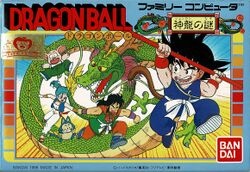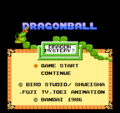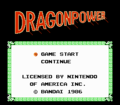E-123Wario54 (talk | contribs) m (+template) |
m (Text replacement - "http://www.romhacking.net/trans/" to "https://www.romhacking.net/translations/") |
||
| (3 intermediate revisions by 3 users not shown) | |||
| Line 1: | Line 1: | ||
{{Header Nav|game=Dragon Ball: Shenron no Nazo | {{Header Nav|game=Dragon Ball: Shenron no Nazo}} | ||
{{ | {{Game | ||
|completion=4 | |||
|image=Dragon Ball Shenron no Nazo FC box.jpg | |||
|title=Dragon Ball: Shenron no Nazo | |title=Dragon Ball: Shenron no Nazo | ||
| | |japanese=ドラゴンボール 神龍の謎 | ||
|developer=[[Bandai]] | |developer=[[Bandai]] | ||
|publisher=[[Bandai]] | |publisher=[[Bandai]] | ||
| | |year=1986 | ||
| | |systems={{syslist|nes}} | ||
|genre=[[Action]] | |genre=[[Action]] | ||
|players=1 | |players=1 | ||
|modes=[[Single player]] | |||
|followed by=[[Dragon Ball: Daimaou Fukkatsu]] | |followed by=[[Dragon Ball: Daimaou Fukkatsu]] | ||
|series=Dragon Ball | |series=Dragon Ball | ||
}} | }} | ||
'''Dragon Ball: Shenron no Nazo''' (or Dragon Ball: Shenlong's Riddle), released in 1986 for the [[Famicom]], was the second Dragon Ball console game published in Japan, but the first published in United States and Europe. (The first Dragon Ball game in Japan for a console was published earlier that year for Epoch's Super Cassette Vision.) This game is one of the two Dragon Ball NES/Famicom games not part of the Card Battle series. It was the ninth best selling Famicom game released in 1986, selling approximately 1,250,000 copies in its lifetime. The game was also included in the Japanese release of the [[Nintendo DS]] game [[Dragon Ball DS 2]]. | |||
The game stars Son Goku and very roughly follows the first two volumes of the Dragon Ball manga, culminating in the first wish from Shenron. (In the US, this portion of the storyline is often called the Emperor Pilaf Saga.) The game consists of 2D overhead areas where Goku must fight many enemies and side scrolling sequences for the boss fights. | |||
The game stars Son Goku and very roughly follows the first two volumes of the Dragon Ball manga, culminating in the first wish from | |||
== US release == | == US release == | ||
The US release, '''Dragon Power''', was notably the only Dragon Ball-related game to be released in the US for the NES. Although the Japanese and European editions of the game used the familiar art and music from the Dragon Ball anime, the US edition made several graphical and translation changes to make the game more easily understood by the audience as the series would not be dubbed into English for another ten years. The box art features an Americanized Kung Fu stereotype. In the game, Goku has been modified to look more like a monkey. | The US release, '''Dragon Power''', was notably the only Dragon Ball-related game to be released in the US for the NES. Although the Japanese and European editions of the game used the familiar art and music from the Dragon Ball anime, the US edition made several graphical and translation changes to make the game more easily understood by the audience as the series would not be dubbed into English for another ten years. The box art features an Americanized Kung Fu stereotype. In the game, Goku has been modified to look more like a monkey. Master Roshi, similarly has been changed to look more like a traditional martial arts master. | ||
Despite these cosmetic changes, the game is still very recognizably a Dragon Ball game and all other plot elements (the search for the Dragon Balls, etc.) remain the same, albeit with name changes. As typical for early Dragon Ball imports, character names are not wholly consistent with the ones from the current translations. Bulma is called "Nora", Yamcha is called "Lancer", Oolong is called "Pudgy", the Kamehameha is the "Wind Wave", and the Dragon Balls are referred to as "Crystalballs". Many of the more racier points in the game (such as when Bulma shows Master Roshi her panties) have been censored or changed. | Despite these cosmetic changes, the game is still very recognizably a Dragon Ball game and all other plot elements (the search for the Dragon Balls, etc.) remain the same, albeit with name changes. As typical for early Dragon Ball imports, character names are not wholly consistent with the ones from the current translations. Bulma is called "Nora", Yamcha is called "Lancer", Oolong is called "Pudgy", the Kamehameha is the "Wind Wave", and the Dragon Balls are referred to as "Crystalballs". Many of the more racier points in the game (such as when Bulma shows Master Roshi her panties) have been censored or changed. | ||
=== Translation === | === Translation === | ||
In March of 1999, the translation group TransBRC released the latest version (v1.11) of their English translation patch for the original Japanese game. | In March of 1999, the translation group TransBRC released the latest version (v1.11) of their English translation patch for the original Japanese game. It is extremely rough, and uses a lot of broken or fragmented English, but it retains all of the correct naming conventions for the Dragon Ball series, with none of the censorship. You can find the patch [https://www.romhacking.net/translations/131/ here], but it requires a change to the NES ROM mapper in order to function properly. Patching it to the original ROM unaltered will not work. | ||
<gallery> | <gallery> | ||
File:Dragon Ball FC flyer.jpg|Promotional flyer | |||
File:Dragon Ball NES EU box.jpg|European box | |||
File:Dragon Power NES box.jpg|American box | |||
</gallery> | </gallery> | ||
<gallery> | <gallery> | ||
File:Dragon Ball Shenron no Nazo title.png|Translated original title screen | |||
File:Dragon Power title.png|American title screen | |||
</gallery> | </gallery> | ||
| Line 42: | Line 41: | ||
[[Category:Bandai]] | [[Category:Bandai]] | ||
[[Category:Action]] | [[Category:Action]] | ||
[[Category:Single player]] | [[Category:Single player]] | ||
Latest revision as of 00:44, 25 July 2022

| Dragon Ball: Shenron no Nazo | |
|---|---|
| Developer(s) | Bandai |
| Publisher(s) | Bandai |
| Year released | 1986 |
| System(s) | NES |
| Followed by | Dragon Ball: Daimaou Fukkatsu |
| Series | Dragon Ball |
| Japanese title | ドラゴンボール 神龍の謎 |
|---|---|
| Genre(s) | Action |
| Players | 1 |
| Modes | Single player |
Dragon Ball: Shenron no Nazo (or Dragon Ball: Shenlong's Riddle), released in 1986 for the Famicom, was the second Dragon Ball console game published in Japan, but the first published in United States and Europe. (The first Dragon Ball game in Japan for a console was published earlier that year for Epoch's Super Cassette Vision.) This game is one of the two Dragon Ball NES/Famicom games not part of the Card Battle series. It was the ninth best selling Famicom game released in 1986, selling approximately 1,250,000 copies in its lifetime. The game was also included in the Japanese release of the Nintendo DS game Dragon Ball DS 2.
The game stars Son Goku and very roughly follows the first two volumes of the Dragon Ball manga, culminating in the first wish from Shenron. (In the US, this portion of the storyline is often called the Emperor Pilaf Saga.) The game consists of 2D overhead areas where Goku must fight many enemies and side scrolling sequences for the boss fights.
US release[edit]
The US release, Dragon Power, was notably the only Dragon Ball-related game to be released in the US for the NES. Although the Japanese and European editions of the game used the familiar art and music from the Dragon Ball anime, the US edition made several graphical and translation changes to make the game more easily understood by the audience as the series would not be dubbed into English for another ten years. The box art features an Americanized Kung Fu stereotype. In the game, Goku has been modified to look more like a monkey. Master Roshi, similarly has been changed to look more like a traditional martial arts master.
Despite these cosmetic changes, the game is still very recognizably a Dragon Ball game and all other plot elements (the search for the Dragon Balls, etc.) remain the same, albeit with name changes. As typical for early Dragon Ball imports, character names are not wholly consistent with the ones from the current translations. Bulma is called "Nora", Yamcha is called "Lancer", Oolong is called "Pudgy", the Kamehameha is the "Wind Wave", and the Dragon Balls are referred to as "Crystalballs". Many of the more racier points in the game (such as when Bulma shows Master Roshi her panties) have been censored or changed.
Translation[edit]
In March of 1999, the translation group TransBRC released the latest version (v1.11) of their English translation patch for the original Japanese game. It is extremely rough, and uses a lot of broken or fragmented English, but it retains all of the correct naming conventions for the Dragon Ball series, with none of the censorship. You can find the patch here, but it requires a change to the NES ROM mapper in order to function properly. Patching it to the original ROM unaltered will not work.
-
Promotional flyer
-
European box
-
American box
-
Translated original title screen
-
American title screen
Table of Contents
- Meeting Kame (Turtle Hermit)
- Oolong!? (Pudgey)
- Yamcha the Thief (Desert Gang, Lancer)
- The Ox King's Fire (King Ox)
- Carrots (Rabbit Gang)
- King Pilaf (King Minos)
- Kung-Fu Level 1
- Kung-Fu Level 2
- Kung-Fu Level 3
- Kung-Fu Level Final
- Rabbit Revenge (Rabbit Gang 2)
- 7 Islands (The Seven Islands)
- King Binbo! (The Jungle)
- Up Tower (Tall Tower)




